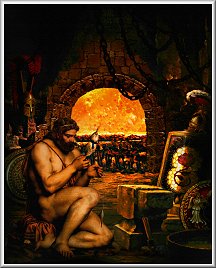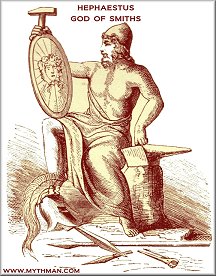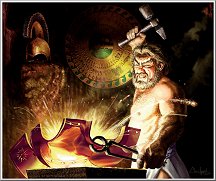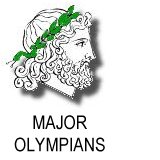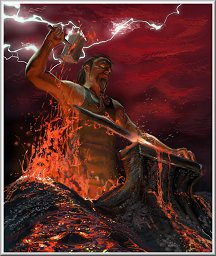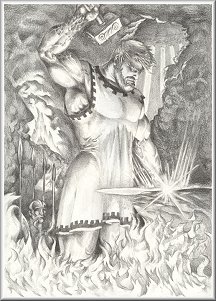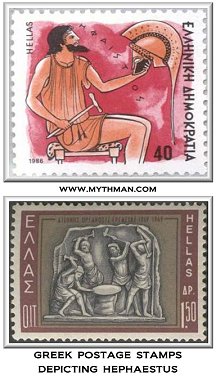MYTH MAN'S AWARD-WINNING HOMEWORK HELP
HEPHAESTUS, GOD OF THE SMITHS, FIRE AND THE FORGE
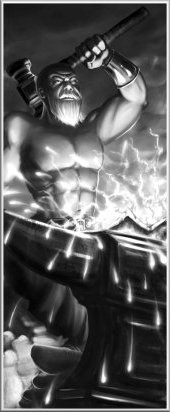
Hephaestus was the God of Fire and the Forge, the patron god
of smiths, craftsmen, sculptors and artisans. He was the weapon maker of the
gods and god of metal, fire and volcanoes. His chosen symbols are a smith's
hammer, an anvil and tongs.
He was the son of Zeus and Hera, although it is
sometimes said that Hera conceived him by herself and without any help
from Zeus. Hera wanted to get back at Zeus because she was angry at her
husband for birthing Athena from his own head without first procreating
with her.
Of all the gods, Hephaestus was the only one to be
physically ugly, and he was also lame. But of all the gods, it was the
deformed Hephaestus who created the greatest works of beauty.
There are two slightly different accounts of how he
became lame. One version is that Hera was so upset at having an ugly
child that she flung him off Mount Olympus and into the sea, breaking
his legs in the process. Later, Hephaestus took revenge on his mother by
building her a golden throne which bound her with invisible fetters when
she sat on it, and would not release her until Hera had agreed to
all his demands.
The other version is that Hephaestus tried to, and
almost did, free his mother when Zeus punished her by hanging her on a
golden chain between heaven and earth; and Zeus, in anger in at his
son’s interference, hurled him off Olympus himself.
But most sources claim that Hephaestus landed in the
sea near the island of Lemnos, and was washed up by the surf on the
shore, where his body lay broken until rescued by the Nereids, Thetis
and Eurynome (mother of the Graces).
These beautiful Nereids took great care to hide him
from his mother who, still ashamed of her deformed son, would have
continued to try to harm him. Secretly Hephaestus lived with these
goddesses in their underwater caves for nine years, and that was the
awakening his creative energy.
There, he began to craft beautiful jewelry from the
multi-colored underwater coral reefs, and from the variety of precious
metals found underwater. To compensate for his lameness, Hephaestus
built two golden robots to help him move around, and also the twelve
splendid thrones of Olympus. Helped by the Cyclops, who were master
craftsmen in their own right, he continued to develop his skills with
decorative iron and other metals, creating beautiful gifts for his
surrogate mothers, the Nereids.
It wasn't long before Hera saw Thetis wearing some of
the beautiful jewelry he had created and demanded to know the source of
this divine craftwork. She could tell that no mere mortal could create
anything resembling such exquisite work. When she learned it was her own
son Hephaestus, she realized that although physically deformed, her son
was capable of unsurpassed creations. All of a sudden his deformity
didn't matter.
Hera forgave him for not being all she had hoped for,
and asked for her husband Zeus to return him to his rightful place up on
exalted Mount Olympus. But Hephaestus was quite happy living on Lemnos
and was still understandably angry at his mother for her past treatment
of him. He refused to comply with the order.
Finally, Zeus resorted to trickery. The King of the
Olympians sent Dionysus, Hephaestus' brother and the god of wine, to
intoxicate him and persuade him to return. Hephaestus had never
experienced wine, and was drunk in no time. Thus out of his mind, and
agreeable to just about anything, Hephaestus then mounted a donkey and,
accompanied by Dionysus, rode back to the palace at Mount Olympus.
Hera wisely declared him her son, even though
Hephaestus himself claimed to have no mother, and that was how he
returned to his rightful place and became one of the Olympians. Many
ancient Greek vase painters were fond of depicting Hephaestus'
triumphant return to Olympus.
Once back among his fellow gods on Mount Olympus,
Hephaestus chose to live underground, where he could work as an artisan
undisturbed. Hera grew to like her lame son, and felt very guilty for
her previous vile conduct towards him. She gave Hephaestus a massive
workshop with many bellows, anvils, and helpers; there he continue to
create beautiful ornaments, weapons, furniture and jewelry to the
endless amusement and delight of the Olympian gods and goddesses. To
help him in his workshop, he forged handmaidens out of gold, who were
able to move around and help him in his work.
In Homer's Iliad his wife is said to be Aglaia
(Splendor), one of the Graces; in the Odyssey she is Aphrodite. But the
commonly held belief is that Zeus, greatly regretting his previous
enmity towards this talented god, and knowing that he could make great
use of Hephaestus' skills, gifted Aphrodite to Hephaestus as his wife.
Zeus felt that the beautiful goddess of love would
arouse the passions of the other Olympians, leading to great hostility
and bickering, and decided that the steady and easygoing god of the
forge would make a solid partner for her. Aphrodite was not happy to be
joined with such an unattractive mate, but knew that it was a marriage
only in name and did not refuse. Her numerous extramarital affairs
scandalized Olympus and often made poor Hephaestus the butt of many
jokes from his fellow Olympians.
Hephaestus was a kind and peace-loving god, gentle
and introverted and popular both in heaven and on earth. Along with
Athena his patronage was very important to life in the city, because
they were the patrons of the handicrafts, which along with agriculture
were the lifeline and support of civilization. Hephaestus protected the
smiths and Athena the weavers, and the people revered and paid homage to
these important deities.
Physically, Hephaestus was generally represented as a
sturdy and muscular man with a thick neck and hairy chest who, because
of a shortened, lame leg and club foot, supported himself with the aid
of a crutch. Bearded, this blue collar god most often was shown dressed
in a ragged sleeveless tunic and woolen hat.
Most frequently, he was portrayed in art holding the
heavy tools of his trade, especially the blacksmith's hammer and tongs.
Sometimes in artistic depictions, he was surrounded by the Kabeiroi, the
dwarflike blacksmith servants of the Mother Goddess who helped in his
subterranean forge, deep below Olympus.
He was worshipped by all blacksmiths and artisans,
who recognized him as their special patron and venerated him
accordingly. Two great festivals, the Vulcanalia (celebrated by the
Romans on August 23, the first day of Virgo) and the Hephaestia were
celebrated in his honor.
His beautiful and
detailed creations
included the following wonders:
Aphrodite's golden girdle, which when worn made her
completely irresistible to both mortals and gods
The silver bows and arrows of Artemis and
Apollo
His robotic helpers, the handmaidens of gold, and the
twenty three-legged stools that ran to service the banquets of the
Olympians
The palaces and homes of the Olympians, with their
unbreakable locks, as well as their twelve splendid thrones.
The famous Shield of Achilles
Heracles' (Hercules') golden breastplate
The exquisite Necklace of Harmonia
Athena's spear, Apollo's chariot and Demeter's sickle
The awesome scepter of Zeus
The golden bed of Helios, the sun god, which carries
him as he sleeps
The armor of the gods in their war against the Titans
Various marvelous jewelry for Aphrodite and his
Nereid surrogate mothers
The Aegis, emblazoned with the head of Medusa,
carried by both Zeus and his daughter Athena
The invisible silver net that captured his cheating
wife Aphrodite and Ares in bed
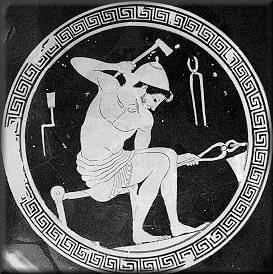
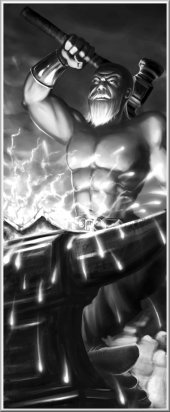

[HOME] [MYTHOLOGY'S EFFECTS ON
MODERN SOCIETY][OLYMPIANS]
[GALLERY] [MAJOR
GODS] [MINOR
GODS] [HEROES]
[CONTACT]
[LOVE STORIES]
[MYTH OF THE MONTH]
[FUN STUFF] [CREATURES]
